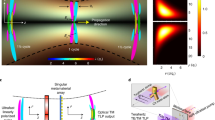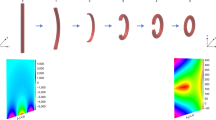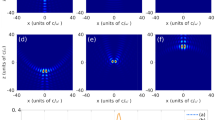Abstract
The toroidal dipole is a localized electromagnetic excitation, distinct from the magnetic and electric dipoles. While the electric dipole can be understood as a pair of opposite charges and the magnetic dipole as a current loop, the toroidal dipole corresponds to currents flowing on the surface of a torus. Toroidal dipoles provide physically significant contributions to the basic characteristics of matter including absorption, dispersion and optical activity. Toroidal excitations also exist in free space as spatially and temporally localized electromagnetic pulses propagating at the speed of light and interacting with matter. We review recent experimental observations of resonant toroidal dipole excitations in metamaterials and the discovery of anapoles, non-radiating charge-current configurations involving toroidal dipoles. While certain fundamental and practical aspects of toroidal electrodynamics remain open for the moment, we envision that exploitation of toroidal excitations can have important implications for the fields of photonics, sensing, energy and information.
This is a preview of subscription content, access via your institution
Access options
Subscribe to this journal
Receive 12 print issues and online access
$259.00 per year
only $21.58 per issue
Buy this article
- Purchase on Springer Link
- Instant access to full article PDF
Prices may be subject to local taxes which are calculated during checkout





Similar content being viewed by others
References
Raab, R. E. & de Lange, O. L. Multipole Theory in Electromagnetism (Oxford University Press, 2004).
Dubovik, V. M., Tosunyan, L. A. & Tugushev, V. V. Axial toroidal moments in electrodynamics and solid-state physics. Zh. Eksp.Teor. Fiz. 90, 590–605 (1986); (English translation in Sov. Phys. JETP 63, 344–351).
Dubovik, V. M. & Tugushev, V. V. Toroid moments in electrodynamics and solid-state physics. Phys. Rep. 187, 145–202 (1990).
Vrejoiu, C. Electromagnetic multipoles in Cartesian coordinates. J. Phys. A. Math. Gen. 35, 9911–9922 (2002).
Gongora, A. T. & Ley-Koo, E. Complete electromagnetic multipole expansion including toroidal moments. Rev. Mex. Fís 52, 188–197 (2006).
Zel'Dovich, Ia. B. Electromagnetic interaction with parity violation. J. Exp. Theor. Phys. 33, 1531–1533 (1957).
Flambaum, V. V. & Murray, D. W. Anapole moment and nucleon weak interactions. Phys. Rev. C 56, 1641–1644 (1997).
Flambaum, V. V. & Khriplovich, I. B. P-odd nuclear forces — a source of parity violation in atoms. Zh. Eksp.Teor. Fiz 79, 1656–1663 (1980); (English translation in Sov. Phys. JETP 52, 835–839).
Ceulemans, A. & Chibotaru, L. F. Molecular anapole moments. Phys. Rev. Lett. 80, 1861–1864 (1998).
Afanasiev, G. N. Simplest sources of electromagnetic fields as a tool for testing the reciprocity-like theorems. J. Phys. D. Appl. Phys. 34, 539 (2001).
Afanasiev, G. N. & Dubovik, V. M. Some remarkable charge–current configurations. Phys. Part. Nuclei 29, 366–391 (1998).
Dubovik, V. M. & Cheshkov, A. A. Multipole expansion in classic and quantum field theory and radiation. Sov. J. Particles. Nucl. 5, 318–337 (1974).
Afanasiev, G. N. The electromagnetic field of solenoids with time-dependent currents. J. Phys. A. Math. Gen. 23, 5755–5764 (1990).
Afanasiev, G. N. & Stepanovsky, Y. P. The electromagnetic field of elementary time-dependent toroidal sources. J. Phys. A. Math. Gen. 28, 4565–4580 (1995).
Radescu, E. E. & Vlad, D. H. Angular momentum loss by a radiating toroidal dipole. Phys. Rev. E 57, 6030–6037 (1998).
Radescu, E. E. & Vaman, G. Exact calculation of the angular momentum loss, recoil force, and radiation intensity for an arbitrary source in terms of electric, magnetic, and toroid multipoles. Phys. Rev. E 65, 046609 (2002).
Spaldin, N. A., Fiebig, M. & Mostovoy, M. The toroidal moment in condensed-matter physics and its relation to the magnetoelectric effect. J. Phys. Condens. Matter 20, 434203 (2008).
Kittel, C. Theory of the structure of ferromagnetic domains in films and small particles. Phys. Rev. 70, 965–971 (1946).
Zheludev, I. S., Perekalina, T. M., Smirnovskaya, E. M., Fonton, S. S. & Yarmukhamedov, Y. N. Magnetic properties of nickel-boracite iodide. JETP Lett. 20, 129–130 (1974).
Ginzburg, V. L., Gorbatsevich, A. A., Kopayev, Y. V. & Volkov, B. A. On the problem of superdiamagnetism. Solid State Commun. 50, 339–343 (1984).
Sannikov, D. G. & Zheludev, I. S. On the possibility of phase transitions with spontaneous toroidal moment formation in nickel boracites. Sov. Phys. Solid State 27, 826–828 (1985).
Crone J. C. & Chung, P. W. Modeling of Toroidal Ordering in Ferroelectric Nanodots (Army Research Laboratory, 2007).
Dubovik, V. M. Material equations for electromagnetism with toroidal polarizations. Phys. Rev. E 61, 7087–7097 (2000).
Ederer, C. & Spaldin, N. A. Towards a microscopic theory of toroidal moments in bulk periodic crystals. Phys. Rev. B 76, 214404 (2007).
Van Aken, B. B., Rivera, J.-P., Schmid, H. & Fiebig, M. Observation of ferrotoroidic domains. Nature 449, 702–705 (2007).
Naumov, I. I., Bellaiche, L. & Fu, H. Unusual phase transitions in ferroelectric nanodisks and nanorods. Nature 432, 737–740 (2004).
Planes, A., Castán, T. & Saxena, A. Recent progress in the thermodynamics of ferrotoroidic materials. Multiferroic Mater. 1, 9–22 (2015).
Khomskii, D. Classifying multiferroics: mechanisms and effects. Physics 2, 20 (2009).
Pyatakov, A. P. & Zvezdin, A. K. Magnetoelectric and multiferroic media. Phys. Usp. 55, 557–581 (2012).
Tolstoi, N. A. & Spartakov, A. A. Aromagnetism: a new type of magnetism. JETP Lett. 52, 161–164 (1990).
Fedotov, V. A., Marinov, K., Boardman, A. D. & Zheludev, N. I. On the aromagnetism and anapole moment of anthracene nanocrystals. New J. Phys. 9, 95 (2007).
Martsenyuk, M. A. & Martsenyuk, N. M. Origin of aromagnetism. JETP Lett. 53, 243–246 (1991).
Toledano, P., Khalyavin, D. D. & Chapon, L. C. Spontaneous toroidal moment and field-induced magnetotoroidic effects in Ba2CoGe2O7 . Phys. Rev. B 84, 094421 (2011).
Tokura, Y. Multiferroics — toward strong coupling between magnetization and polarization in a solid. J. Magn. Magn. Mater. 310, 1145–1150 (2007).
Sannikov, D. G. Phenomenological theory of the magnetoelectric effect in some boracites. Zh. Eksp. Teor. Fiz. 111, 536–546 (1997); (English translation in J. Exp. Theor. Phys. 84, 293–299).
Mettout, B., Tolédano, P. & Fiebig, M. Symmetry replication and toroidic effects in the multiferroic pyroxene NaFeSi2O6 . Phys. Rev. B 81, 214417 (2010).
Feng, H.-J. & Liu, F.-M. Ab initio prediction on ferrotoroidic and electronic properties of olivine Li4 MnFeCoNiP4O16 . Chinese Phys. B 18, 2481–2486 (2009).
Hayami, S., Kusunose, H. & Motome, Y. Toroidal order in metals without local inversion symmetry. Phys. Rev. B 90, 024432 (2014).
Yamaguchi, Y. & Kimura, T. Magnetoelectric control of frozen state in a toroidal glass. Nature Commun. 4, 2063 (2013).
Lin, S.-Y. et al. Coupling Dy3 triangles to maximize the toroidal moment. Angew. Chem. Int. Ed. 51, 12767–12771 (2012).
Berger, R. J. F. Prediction of a cyclic helical oligoacetylene showing anapolar ring currents in the magnetic field. Z. Naturforsch. B 67b, 1127–1131 (2012).
Popov, Y. F. et al. Magnetoelectric effect and toroidal ordering in Ga2−xFexO3 . Zh. Eksp. Teor. Fiz. 114, 263–272 (1998); (English translation in J. Exp. Theor. Phys. 87, 146–151).
Ressouche, E. et al. Magnetoelectric MnPS3 as a candidate for ferrotoroidicity. Phys. Rev. B 82, 100408 (2010).
Zimmermann, A. S., Meier, D. & Fiebig, M. Ferroic nature of magnetic toroidal order. Nature Commun. 5, 4796 (2014).
Grahn, P., Shevchenko, A. & Kaivola, M. Electromagnetic multipole theory for optical nanomaterials. New J. Phys. 14, 093033 (2012).
Arango, F. B. & Koenderink, A. F. Polarizability tensor retrieval for magnetic and plasmonic antenna design. New J. Phys. 15, 073023 (2013).
Cho, K. Microscopic Expression of Chiral Susceptibilities. Metamaterials '2011: The Fifth International Congress on Advanced Electromagnetic Materials in Microwaves and Optics 672–674 (2011); http://go.nature.com/PNQmvj
Miroshnichenko, A. E. et al. Nonradiating anapole modes in dielectric nanoparticles. Nature Commun. 6, 8069 (2015).
Zhang, X.-L., Wang, S. B., Lin, Z., Sun, H.-B. & Chan, C. T. Optical force on toroidal nanostructures: toroidal dipole versus renormalized electric dipole. Phys. Rev. A 92, 043804 (2015).
Savinov, V., Fedotov, V. A. & Zheludev, N. I. Toroidal dipolar excitation and macroscopic electromagnetic properties of metamaterials. Phys. Rev. B 89, 205112 (2014).
Kaelberer, T., Fedotov, V. A., Papasimakis, N., Tsai, D. P. & Zheludev, N. I. Toroidal dipolar response in a metamaterial. Science 330, 1510–1512 (2010).
Aggarwal K. M. Keenan, F. P. Radiative rates for E1, E2, M1 and M2 transitions in Fe X. Astron. Astrophys. 427, 763–767 (2004).
Marinov, K., Boardman, A. D., Fedotov, V. A. & Zheludev, N. I. Toroidal metamaterial. New J. Phys. 9, 324 (2007).
Papasimakis, N., Fedotov, V. A., Marinov, K. & Zheludev, N. I. Gyrotropy of a metamolecule: wire on a torus. Phys. Rev. Lett. 103, 093901 (2009).
Dong, Z.-G., Ni, P., Zhu, J., Yin, X. & Zhang, X. Toroidal dipole response in a multifold double-ring metamaterial. Opt. Express 20, 13065–13070 (2012).
Ye, Q. W. et al. The magnetic toroidal dipole in steric metamaterial for permittivity sensor application. Phys. Scripta 88, 055002 (2013).
Fan, Y., Wei, Z., Li, H., Chen, H. & Soukoulis, C. M. Low-loss and high-Q planar metamaterial with toroidal moment. Phys. Rev. B 87, 115417 (2013).
Savinov, V., Delfanazari, K., Fedotov, V. A. & Zheludev, N. I. Planar superconducting toroidal metamaterial: a source for oscillating vector-potential? 2014 Conference on Lasers and Electro-Optics (CLEO) FTu1C.1 (2014).
Ding, C. et al. Stable terahertz toroidal dipolar resonance in a planar metamaterial. Phys. Status Solidi 252, 1388–1393 (2015).
Huang, Y. W. et al. Design of plasmonic toroidal metamaterials at optical frequencies. Opt. Express 20, 1760–1768 (2012).
Wu, P. C. et al. Three-dimensional metamaterials: from split ring resonator to toroidal metamolecule. Proc. SPIE 9163 (2014).
Dong, Z.-G. et al. Optical toroidal dipolar response by an asymmetric double-bar metamaterial. Appl. Phys. Lett. 101, 144105 (2012).
Dong, Z.-G. et al. All-optical Hall effect by the dynamic toroidal moment in a cavity-based metamaterial. Phys. Rev. B 87, 245429 (2013).
Zhang, Q., Xiao, J. J. & Wang, S. L. Optical characteristics associated with magnetic resonance in toroidal metamaterials of vertically coupled plasmonic nanodisks. J. Opt. Soc. Am. B 31, 1103–1108 (2014).
Liu, W., Zhang, J. & Miroshnichenko, A. E. Toroidal dipole induced transparency in core-shell nanoparticles. Laser Photon. Rev. 9, 564–570 (2015).
Kim, S.-H. et al. Subwavelength localization and toroidal dipole moment of spoof surface plasmon polaritons. Phys. Rev. B 91, 035116 (2015).
Li, J. et al. Excitation of plasmon toroidal mode at optical frequencies by angle-resolved reflection. Opt. Lett. 39, 6683–6686 (2014).
Ögüt, B., Talebi, N., Vogelgesang, R., Sigle, W. & van Aken, P. A. Toroidal plasmonic eigenmodes in oligomer nanocavities for the visible. Nano Lett. 12, 5239–5244 (2012).
Huang, Y. W. et al. Toroidal lasing spaser. Sci. Rep. 3, 1237 (2013).
Basharin, A. A. et al. Dielectric metamaterials with toroidal dipolar response. Phys. Rev. X 5, 011036 (2015).
Vinogradov, A. P. & Aivazyan, A. V. Scaling theory for homogenization of the Maxwell equations. Phys. Rev. E 60, 987–993 (1999).
Fernandez-Corbaton, I., Nanz, S. & Rockstuhl, C. On the dynamic toroidal multipoles. Preprint at http://arxiv.org/abs/1507.00755 (2015).
Fedotov, V. A., Rogacheva, A. V., Savinov, V., Tsai, D. P. & Zheludev, N. I. Resonant transparency and non-trivial non-radiating excitations in toroidal metamaterials. Sci. Rep. 3, 2967 (2013).
Liu, W., Zhang, J., Lei, B., Hu, H. & Miroshnichenko, A. E. Invisible nanowires with interfering electric and toroidal dipoles. Opt. Lett. 40, 2293–2296 (2015).
Boardman, A. D. & Marinov, K., Zheludev, N. I. & Fedotov, V. A. Dispersion properties of nonradiating configurations: finite-difference time-domain modeling. Phys. Rev. E 72, 036603 (2005).
Marengo, E. A. & Ziolkowski, R. W. Nonradiating sources, the Aharonov-Bohm effect, and the question of measurability of electromagnetic potentials. Radio Sci. 37, 10–19 (2002).
Zagoskin, A. M., Chipouline, A., Il'ichev, E., Johansson, J. R. & Nori, F. Toroidal qubits: naturally-decoupled quiet artificial atoms. Preprint at: http://arxiv.org/abs/1406.7678 (2014).
Raybould, T. A. et al. Toroidal optical activity. Preprint at: http://arxiv.org/abs/1508.06192 (2015).
Hellwarth, R. W. & Nouchi, P. Focused one-cycle electromagnetic pulses. Phys. Rev. E 54, 889 (1996).
Zheludev, N. I., Fedotov, V., Papasimakis, N., Savinov, V. & Raybould, T. Propagating and localized toroidal excitations in free space and metamaterials. Proc. SPIE 9544 (2015).
Raybould, T. A., Fedotov, V. A., Papasimakis, N., Youngs, I. J. & Zheludev, N. I. Focused electromagnetic doughnut pulses and their interaction with interfaces and nanostructures. Opt. Express 24, 3150–3161 (2016).
Ziolkowski, R. W. Localized transmission of electromagnetic energy. Phys. Rev. A 39, 2005–2033 (1989).
Ziolkowski, R. W. Properties of electromagnetic beams generated by ultra-wide bandwidth pulse-driven arrays. IEEE Trans. Antennas Propag. 40, 888–905 (1992).
Lemak, S. et al. Toroidal structure and DNA cleavage by the CRISPR-associated [4Fe-4S]-cluster containing Cas4 nuclease SSO0001 from Sulfolobus solfataricus. J. Am. Chem. Soc. 135, 17476–17487 (2013).
Watson, D. W., Jenkins, S. D., Ruostekoski, J., Fedotov, V. A. & Zheludev, N. I. Toroidal dipole excitations in metamolecules formed by interacting plasmonic nanorods. Preprint at: http://arxiv.org/abs/1510.05609 (2015).
Bao, Y., Zhu, X. & Fang, Z. Plasmonic toroidal dipolar response under radially polarized excitation. Sci. Rep. 5, 11793 (2015).
Thorner, G., Kiat, J.-M., Bogicevic, C. & Kornev, I. Axial hypertoroidal moment in a ferroelectric nanotorus: a way to switch local polarization. Phys. Rev. B 89, 220103 (2014).
Savinov, V. Novel toroidal and superconducting metamaterials PhD thesis, Univ. Southampton (2014).
Leroy, B. How to convert the equations of electromagnetism from Gaussian to SI units in less than no time. Am. J. Phys. 53, 589–590 (1985).
Bohren, C. F. & Huffman, D. R. Absorption and scattering of light by small particles. (Wiley, 1983).
Acknowledgements
The authors are grateful to Din Ping Tsai, Ian Youngs and Janne Ruostekoski for fruitful discussions and acknowledge the support of the MOE Singapore (grant MOE2011-T3-1-005), the UK's Engineering and Physical Sciences Research Council (grants EP/G060363/1, EP/M008797/1), the Defence Science and Technology Laboratory (grant DSTLX-1000068886) and the Leverhulme Trust.
Author information
Authors and Affiliations
Contributions
All authors made equal contributions to the review and edited the text and figures.
Corresponding author
Rights and permissions
About this article
Cite this article
Papasimakis, N., Fedotov, V., Savinov, V. et al. Electromagnetic toroidal excitations in matter and free space. Nature Mater 15, 263–271 (2016). https://doi.org/10.1038/nmat4563
Received:
Accepted:
Published:
Issue Date:
DOI: https://doi.org/10.1038/nmat4563
This article is cited by
-
Quasi-BIC based all-dielectric metasurfaces for ultra-sensitive refractive index and temperature sensing
Scientific Reports (2023)
-
Wavefront control of subcycle vortex pulses via carrier-envelope-phase tailoring
Light: Science & Applications (2023)
-
In situ activation of flexible magnetoelectric membrane enhances bone defect repair
Nature Communications (2023)
-
An ultra-sensitive metasurface biosensor for instant cancer detection based on terahertz spectra
Nano Research (2023)
-
Plasmonic anapole metamaterial for refractive index sensing
PhotoniX (2022)



